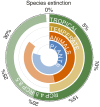Recent responses to climate change reveal the drivers of species extinction and survival
- PMID: 32041877
- PMCID: PMC7049143
- DOI: 10.1073/pnas.1913007117
Recent responses to climate change reveal the drivers of species extinction and survival
Abstract
Climate change may be a major threat to biodiversity in the next 100 years. Although there has been important work on mechanisms of decline in some species, it generally remains unclear which changes in climate actually cause extinctions, and how many species will likely be lost. Here, we identify the specific changes in climate that are associated with the widespread local extinctions that have already occurred. We then use this information to predict the extent of future biodiversity loss and to identify which processes may forestall extinction. We used data from surveys of 538 plant and animal species over time, 44% of which have already had local extinctions at one or more sites. We found that locations with local extinctions had larger and faster changes in hottest yearly temperatures than those without. Surprisingly, sites with local extinctions had significantly smaller changes in mean annual temperatures, despite the widespread use of mean annual temperatures as proxies for overall climate change. Based on their past rates of dispersal, we estimate that 57-70% of these 538 species will not disperse quickly enough to avoid extinction. However, we show that niche shifts appear to be far more important for avoiding extinction than dispersal, although most studies focus only on dispersal. Specifically, considering both dispersal and niche shifts, we project that only 16-30% of these 538 species may go extinct by 2070. Overall, our results help identify the specific climatic changes that cause extinction and the processes that may help species to survive.
Keywords: climate change; disperal; extinction; niche shift.
Conflict of interest statement
The authors declare no competing interest.
Figures




Comment in
-
Niche width predicts extinction from climate change and vulnerability of tropical species.Glob Chang Biol. 2023 Feb;29(3):618-630. doi: 10.1111/gcb.16486. Epub 2022 Nov 8. Glob Chang Biol. 2023. PMID: 36260367
References
-
- Thomas C. D., et al. , Extinction risk from climate change. Nature 427, 145–148 (2004). - PubMed
-
- Loarie S. R., et al. , The velocity of climate change. Nature 462, 1052–1055 (2009). - PubMed
-
- Pimm S. L., Climate disruption and biodiversity. Curr. Biol. 19, R595–R601 (2009). - PubMed
-
- Warren R., et al. , Quantifying the benefit of early climate change mitigation in avoiding biodiversity loss. Nat. Clim. Chang. 3, 678–682 (2013).
-
- Urban M. C., Accelerating extinction risk from climate change. Science 348, 571–573 (2015). - PubMed
Publication types
MeSH terms
Associated data
LinkOut - more resources
Full Text Sources
Other Literature Sources
Medical
Miscellaneous

